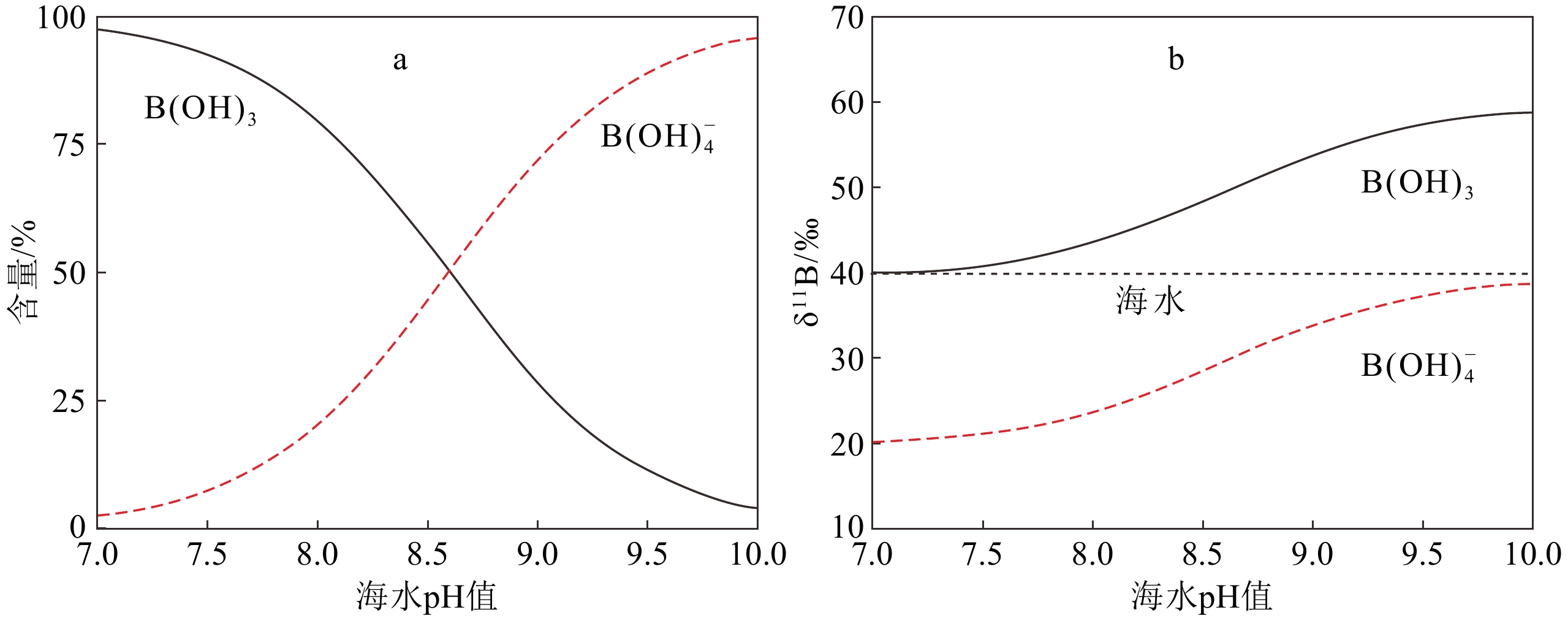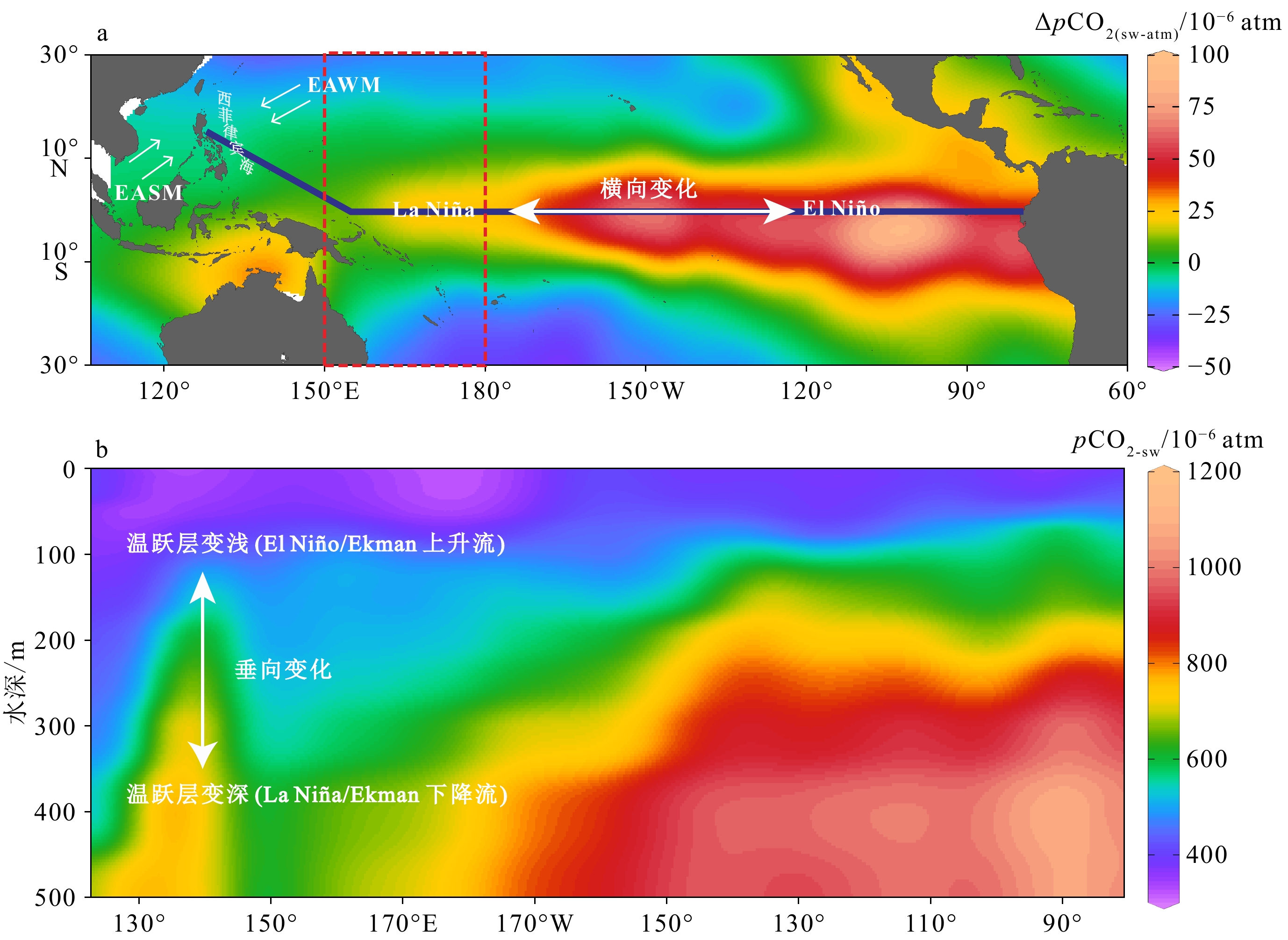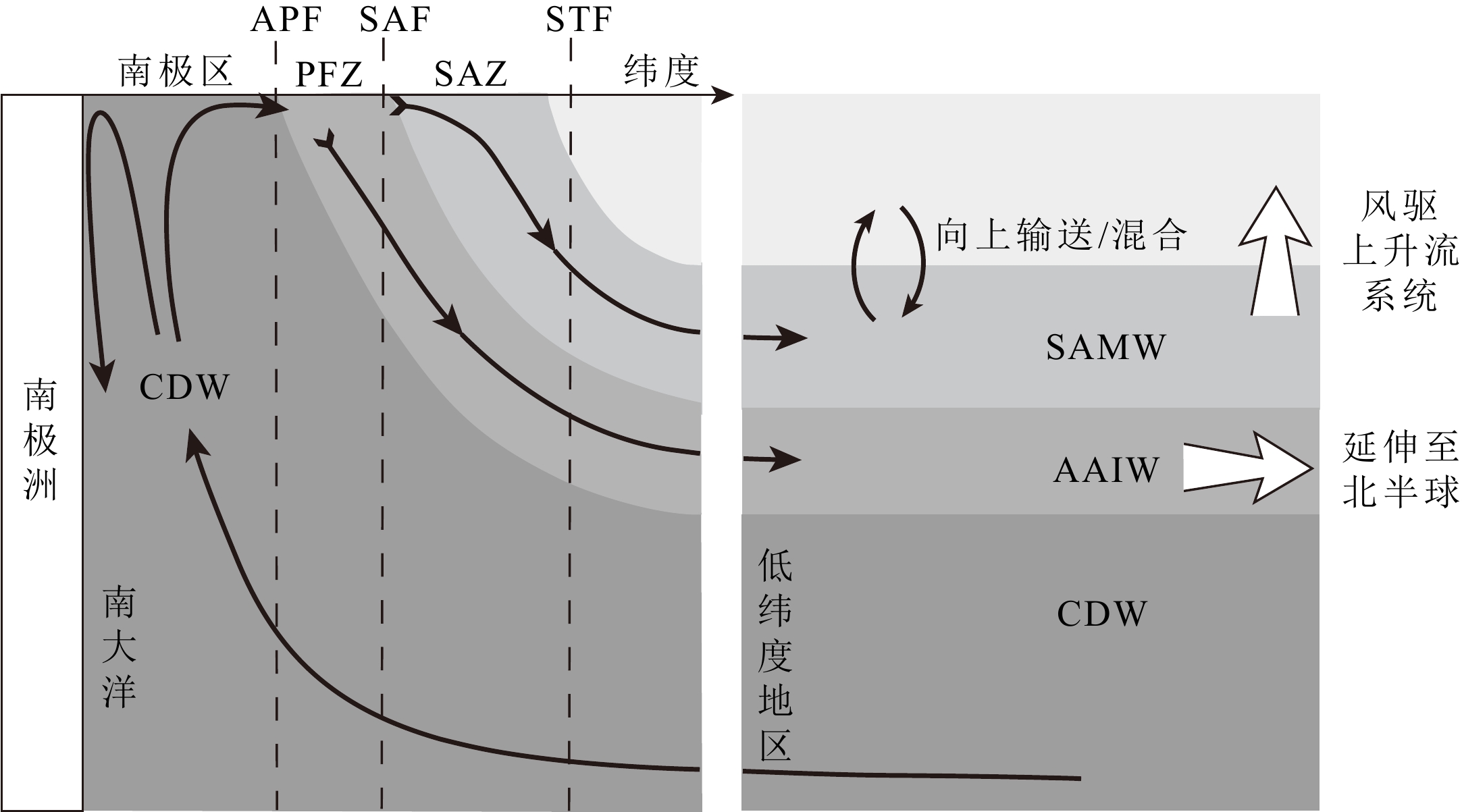Influencing factors of air-sea CO2 exchange in the Western Tropical Pacific during the late Quaternary
-
摘要:
探究海气CO2交换有助于解析全球碳循环和全球气候变化。由于海水和大气的直接接触,研究表层海水碳酸盐系统变化成为探究海气碳交换的关键。基于已有热带西太平洋表层海水碳酸盐系统研究成果,本文总结了有孔虫壳体B/Ca和δ11B指标重建碳酸盐系统参数的原理、方法及优缺点。然后,从厄尔尼诺-南方涛动(El Niño-Southern Oscillation, ENSO)、东亚季风以及大气桥梁和海洋隧道三方面综述了晚第四纪热带西太平洋海气CO2交换影响因素的研究现状。结果显示,类ENSO通过横向平流和垂向变化分别影响热带西太平洋东端和西端的海气碳交换。东亚夏季风对热带西太平洋海气碳交换具有较强的调控作用,而东亚冬季风的调控作用较弱或不明显。冰消期南大洋深部流通状况增强,可通过大气桥梁(大气CO2)和海洋隧道(南极中层水)影响热带西太平洋海气碳交换。然而,为了更准确清晰地了解全球碳循环变化,还需针对指标记录的可靠性、覆盖范围以及海气碳交换在更长时间尺度的变化机理等方面开展更多研究。
Abstract:Exploring air-sea CO2 exchange helps to analyze the global carbon cycle and global climate change. Due to the direct contact between seawater and atmosphere, characterizing the changes in the carbonate system of surface water is the key to explore the air-sea CO2 exchange. Available studies of the sea surface carbonate system in the Western Tropical Pacific (WTP) was reappraised, the principles, methods, advantages and disadvantages of reconstructing carbonate system parameters with foraminiferal B/Ca and δ11B were summarized. Secondly, the research status of influencing factors of air-sea CO2 exchange in the WTP during the late Quaternary was reviewed from three aspects: El Niño-Southern Oscillation (ENSO), East Asian monsoons, and atmospheric bridge and ocean tunnel. Results show that the ENSO-like processes can affect the air-sea CO2 exchange in the eastern and western parts of the WTP via lateral advection and vertical change, respectively. The East Asian summer monsoon regulates the air-sea CO2 exchange in WTP strongly and effectively, while the East Asian winter monsoon, weakly and insignificantly. During the deglaciation period, the increased ventilation of deep water in the Southern Ocean affects the air-sea CO2 exchange in the WTP through the atmospheric bridge (atmospheric CO2) and ocean tunnel (Antarctic Intermediate Water). In the future, more researches are required into the reliability and coverage of proxy records, and the mechanisms of air-sea CO2 exchange over longer time scales, to understand changes in the global carbon cycle more accurately and clearly.
-
Key words:
- planktonic foraminifera /
- B/Ca /
- δ11B /
- ENSO /
- East Asian monsoon /
- Southern Ocean /
- carbon cycle
-

-
图 1 溶解的B随海水pH的演化趋势[13]
Figure 1.
图 3 流进和流出南大洋的水团[27]
Figure 3.
-
[1] Lüthi D, Le Floch M, Bereiter B, et al. High-resolution carbon dioxide concentration record 650, 000–800, 000 years before present[J]. Nature, 2008, 453(7193): 379-382. doi: 10.1038/nature06949
[2] Jouzel J, Masson-Delmotte V, Cattani O, et al. Orbital and millennial Antarctic climate variability over the past 800, 000 years[J]. Science, 2007, 317(5839): 793-796. doi: 10.1126/science.1141038
[3] Bereiter B, Eggleston S, Schmitt J, et al. Revision of the EPICA Dome C CO2 record from 800 to 600 kyr before present[J]. Geophysical Research Letters, 2015, 42(2): 542-549. doi: 10.1002/2014GL061957
[4] Yu J M, Oppo D W, Jin Z D, et al. Millennial and centennial CO2 release from the Southern Ocean during the last deglaciation[J]. Nature Geoscience, 2022, 15(4): 293-299. doi: 10.1038/s41561-022-00910-9
[5] Yamamoto M, Clemens S C, Seki O, et al. Increased interglacial atmospheric CO2 levels followed the mid-Pleistocene Transition[J]. Nature Geoscience, 2022, 15(4): 307-313. doi: 10.1038/s41561-022-00918-1
[6] Nehrbass-Ahles C, Shin J, Schmitt J, et al. Abrupt CO2 release to the atmosphere under glacial and early interglacial climate conditions[J]. Science, 2020, 369(6506): 1000-1005. doi: 10.1126/science.aay8178
[7] Sigman D M, Boyle E A. Glacial/interglacial variations in atmospheric carbon dioxide[J]. Nature, 2000, 407(6806): 859-869. doi: 10.1038/35038000
[8] Siegenthaler U, Stocker T F, Monnin E, et al. Stable carbon cycle-climate relationship during the late pleistocene[J]. Science, 2005, 310(5752): 1313-1317. doi: 10.1126/science.1120130
[9] Zeebe R E, Wolf-Gladrow D. CO2 in Seawater: Equilibrium, Kinetics, Isotopes[M]. Amesterdam: Elsevier, 2001.
[10] Xiong Z F, Li T G, Hönisch B, et al. Monsoon- and ENSO-driven surface-water pCO2 variation in the tropical West Pacific since the Last Glacial Maximum[J]. Quaternary Science Reviews, 2022, 289: 107621. doi: 10.1016/j.quascirev.2022.107621
[11] Guillermic M, Misra S, Eagle R, et al. Seawater pH reconstruction using boron isotopes in multiple planktonic foraminifera species with different depth habitats and their potential to constrain pH and pCO2 gradients[J]. Biogeosciences, 2020, 17(13): 3487-3510. doi: 10.5194/bg-17-3487-2020
[12] Hönisch B, Hemming N G. Surface ocean pH response to variations in pCO2 through two full glacial cycles[J]. Earth and Planetary Science Letters, 2005, 236(1-2): 305-314. doi: 10.1016/j.jpgl.2005.04.027
[13] Yu J M, Elderfield H, Hönisch B. B/Ca in planktonic foraminifera as a proxy for surface seawater pH[J]. Paleoceanography, 2007, 22(2): PA2202.
[14] Guo J T, Li T G, Xiong Z F, et al. Revisiting the dependence of thermocline-dwelling foraminiferal B/Ca on temperature and[CO32−], and its application in reconstruction of the subsurface carbonate system in the tropical western Pacific since 24 ka[J]. Acta Oceanologica Sinica, 2019, 38(9): 71-86. doi: 10.1007/s13131-019-1476-y
[15] Guo J T, Qiu X H, Algeo T J, et al. Precession-driven changes in air-sea CO2 exchange by East Asian summer monsoon in the Western Tropical Pacific since MIS 6[J]. Palaeogeography, Palaeoclimatology, Palaeoecology, 2022, 607: 111267. doi: 10.1016/j.palaeo.2022.111267
[16] Yu J, Menviel L, Jin Z D, et al. Last glacial atmospheric CO2 decline due to widespread Pacific deep-water expansion[J]. Nature Geoscience, 2020, 13(9): 628-633. doi: 10.1038/s41561-020-0610-5
[17] Barker S, Elderfield H. Foraminiferal calcification response to glacial-interglacial changes in atmospheric CO2[J]. Science, 2002, 297(5582): 833-836. doi: 10.1126/science.1072815
[18] Qin B B, Li T G, Xiong Z F, et al. Influences of Atlantic Ocean thermohaline circulation and Antarctic ice-sheet expansion on Pliocene deep Pacific carbonate chemistry[J]. Earth and Planetary Science Letters, 2022, 599: 117868. doi: 10.1016/j.jpgl.2022.117868
[19] Qin B B, Jia Q, Xiong Z F, et al. Sustained deep pacific carbon storage after the mid-pleistocene transition linked to enhanced southern ocean stratification[J]. Geophysical Research Letters, 2022, 49(4): e2021GL097121. doi: 10.1029/2021GL097121
[20] Wan S, Jian Z M, Gong X, et al. Deep water [CO32−] and circulation in the south China sea over the last glacial cycle[J]. Quaternary Science Reviews, 2020, 243: 106499. doi: 10.1016/j.quascirev.2020.106499
[21] Allen K A, Hönisch B. The planktic foraminiferal B/Ca proxy for seawater carbonate chemistry: a critical evaluation[J]. Earth and Planetary Science Letters, 2012, 345-348: 203-211. doi: 10.1016/j.jpgl.2012.06.012
[22] Salmon K H, Anand P, Sexton P F, et al. Calcification and growth processes in planktonic foraminifera complicate the use of B/Ca and U/Ca as carbonate chemistry proxies[J]. Earth and Planetary Science Letters, 2016, 449: 372-381. doi: 10.1016/j.jpgl.2016.05.016
[23] Haynes L L, Hönisch B, Dyez K A, et al. Calibration of the B/Ca proxy in the planktic foraminifer Orbulina universa to Paleocene seawater conditions[J]. Paleoceanography, 2017, 32(6): 580-599. doi: 10.1002/2016PA003069
[24] Dang H W, Wang T T, Qiao P J, et al. The B/Ca and Cd/Ca of a subsurface-dwelling foraminifera Pulleniatina obliquiloculata in the tropical Indo-Pacific Ocean: implications for the subsurface carbonate chemistry estimation[J]. Acta Oceanologica Sinica, 2019, 38(3): 138-150. doi: 10.1007/s13131-019-1406-6
[25] Gray W R, Rae J W B, Wills R C J, et al. Deglacial upwelling, productivity and CO2 outgassing in the North Pacific Ocean[J]. Nature Geoscience, 2018, 11(5): 340-344. doi: 10.1038/s41561-018-0108-6
[26] Foster G L. Seawater pH, pCO2 and [CO32-] variations in the Caribbean Sea over the last 130 kyr: A boron isotope and B/Ca study of planktic foraminifera[J]. Earth and Planetary Science Letters, 2008, 271(1-4): 254-266. doi: 10.1016/j.jpgl.2008.04.015
[27] Anderson R F, Ali S, Bradtmiller L I, et al. Wind-driven upwelling in the Southern Ocean and the deglacial rise in atmospheric CO2[J]. Science, 2009, 323(5920): 1443-1448. doi: 10.1126/science.1167441
[28] Spero H J, Lea D W. The cause of carbon isotope minimum events on glacial terminations[J]. Science, 2002, 296(5567): 522-525. doi: 10.1126/science.1069401
[29] Chen S X, Li T G, Tang Z, et al. Response of the northwestern Pacific upper water δ13C to the last deglacial ventilation of the deep Southern Ocean[J]. Chinese Science Bulletin, 2011, 56(24): 2628-2634. doi: 10.1007/s11434-011-4590-0
[30] Douville E, Paterne M, Cabioch G, et al. Abrupt sea surface pH change at the end of the Younger Dryas in the central sub-equatorial Pacific inferred from boron isotope abundance in corals ( Porites)[J]. Biogeosciences, 2010, 7(8): 2445-2459. doi: 10.5194/bg-7-2445-2010
[31] Takahashi T, Sutherland S C, Wanninkhof R, et al. Climatological mean and decadal change in surface ocean pCO2, and net sea–air CO2 flux over the global oceans[J]. Deep Sea Research Part II: Topical Studies in Oceanography, 2009, 56(8-9): 554-577.
[32] Feely R A, Boutin J, Cosca C E, et al. Seasonal and interannual variability of CO2 in the equatorial Pacific[J]. Deep Sea Research Part II: Topical Studies in Oceanography, 2002, 49(13-14): 2443-2469. doi: 10.1016/S0967-0645(02)00044-9
[33] Yuan X C, Yin K, Cai W J, et al. Influence of seasonal monsoons on net community production and CO2 in subtropical Hong Kong coastal waters[J]. Biogeosciences, 2011, 8(2): 289-300. doi: 10.5194/bg-8-289-2011
[34] Hemming N G, Hanson G N. Boron isotopic composition and concentration in modern marine carbonates[J]. Geochimica et Cosmochimica Acta, 1992, 56(1): 537-543. doi: 10.1016/0016-7037(92)90151-8
[35] Rae J W B, Foster G L, Schmidt D N, et al. Boron isotopes and B/Ca in benthic foraminifera: proxies for the deep ocean carbonate system[J]. Earth and Planetary Science Letters, 2011, 302(3-4): 403-413. doi: 10.1016/j.jpgl.2010.12.034
[36] Branson O, Kaczmarek K, Redfern S A T, et al. The coordination and distribution of B in foraminiferal calcite[J]. Earth and Planetary Science Letters, 2015, 416: 67-72. doi: 10.1016/j.jpgl.2015.02.006
[37] Tripati A K, Roberts C D, Eagle R A. Coupling of CO2 and ice sheet stability over major climate transitions of the last 20 million years[J]. Science, 2009, 326(5958): 1394-1397. doi: 10.1126/science.1178296
[38] Pelletier G, Lewis E, Wallace D. CO2SYS. XLS: a calculator for the CO2 system in seawater for Microsoft Excel/VBA[Z]. Washington State Department of Ecology/Brookhaven National Laboratory, Olympia, WA/Upton, NY, USA, 2007.
[39] Lueker T J, Dickson A G, Keeling C D. Ocean pCO2 calculated from dissolved inorganic carbon, alkalinity, and equations for K1 and K2: validation based on laboratory measurements of CO2 in gas and seawater at equilibrium[J]. Marine Chemistry, 2000, 70(1-3): 105-119. doi: 10.1016/S0304-4203(00)00022-0
[40] Mehrbach C, Culberson C H, Hawley J E, et al. Measurement of the apparent dissociation constants of carbonic acid in seawater at atmospheric pressure[J]. Limnology and Oceanography, 1973, 18(6): 897-907. doi: 10.4319/lo.1973.18.6.0897
[41] Dickson A G, Goyet C. Handbook of methods for the analysis of the various parameters of the carbon dioxide system in sea water. Version 2[R]. Oak Ridge: Oak Ridge National Lab. , 1994.
[42] Lee K, Kim T W, Byrne R H, et al. The universal ratio of boron to chlorinity for the North Pacific and North Atlantic oceans[J]. Geochimica et Cosmochimica Acta, 2010, 74(6): 1801-1811. doi: 10.1016/j.gca.2009.12.027
[43] Babila T L, Rosenthal Y, Conte M H. Evaluation of the biogeochemical controls on B/Ca of Globigerinoides ruber white from the Oceanic Flux Program, Bermuda[J]. Earth and Planetary Science Letters, 2014, 404: 67-76. doi: 10.1016/j.jpgl.2014.05.053
[44] Henehan M J, Foster G L, Rae J W B, et al. Evaluating the utility of B/Ca ratios in planktic foraminifera as a proxy for the carbonate system: a case study of Globigerinoides ruber[J]. Geochemistry, Geophysics, Geosystems, 2015, 16(4): 1052-1069. doi: 10.1002/2014GC005514
[45] Dickson A G. Thermodynamics of the dissociation of boric acid in synthetic seawater from 273.15 to 318.15 K[J]. Deep Sea Research Part A. Oceanographic Research Papers, 1990, 37(5): 755-766. doi: 10.1016/0198-0149(90)90004-F
[46] Klochko K, Kaufman A J, Yao W S, et al. Experimental measurement of boron isotope fractionation in seawater[J]. Earth and Planetary Science Letters, 2006, 248(1-2): 276-285. doi: 10.1016/j.jpgl.2006.05.034
[47] Takahashi T, Sutherland S C, Kozyr A. Global ocean surface water partial pressure of CO2 database (LDEO Database Version 2019): measurements performed during 1957-2019 (NCEI Accession 0160492)[Z]. NOAA National Centers for Environmental Information, 2019.
[48] Pelejero C, Calvo E, McCulloch M T, et al. Preindustrial to modern interdecadal variability in coral reef pH[J]. Science, 2005, 309(5744): 2204-2207. doi: 10.1126/science.1113692
[49] Inoue H Y, Sugimura Y. Variations and distributions of CO2 in and over the equatorial Pacific during the period from the 1986/88 El Niño event to the 1988/89 La Niña event[J]. Tellus B: Chemical and Physical Meteorology, 1992, 44(1): 1-22. doi: 10.3402/tellusb.v44i1.15417
[50] Ishii M, Feely R A, Rodgers K B, et al. Air–sea CO2 flux in the Pacific Ocean for the period 1990–2009[J]. Biogeosciences, 2014, 11(3): 709-734. doi: 10.5194/bg-11-709-2014
[51] Key R M, Kozyr A, Sabine C L, et al. A global ocean carbon climatology: results from Global Data Analysis Project (GLODAP)[J]. Global Biogeochemical Cycles, 2004, 18(4): GB4031.
[52] Schlitzer R. Ocean Data View, v.5.5.1-64 bit (Windows)[EB/OL]. 2021.https://odv.awi.de.
[53] Chiodi A M, Harrison D E. Global seasonal precipitation anomalies robustly associated with El Niño and La Niña Events—an OLR perspective[J]. Journal of Climate, 2015, 28(15): 6133-6159. doi: 10.1175/JCLI-D-14-00387.1
[54] Xiong Z F, Li T G, Chang F M, et al. Rapid precipitation changes in the tropical West Pacific linked to North Atlantic climate forcing during the last deglaciation[J]. Quaternary Science Reviews, 2018, 197: 288-306. doi: 10.1016/j.quascirev.2018.07.040
[55] Tozuka T, Kagimoto T, Masumoto Y, et al. Simulated multiscale variations in the western tropical pacific: the Mindanao dome revisited[J]. Journal of Physical Oceanography, 2002, 32(5): 1338-1359. doi: 10.1175/1520-0485(2002)032<1338:SMVITW>2.0.CO;2
[56] Raven J, Caldeira K, Elderfield H, et al. Ocean Acidification Due to Increasing Atmospheric Carbon Dioxide[M]. London, UK: The Royal Society, 2005.
-




 下载:
下载:

